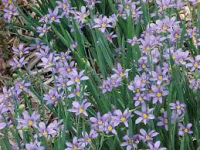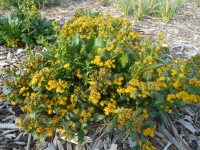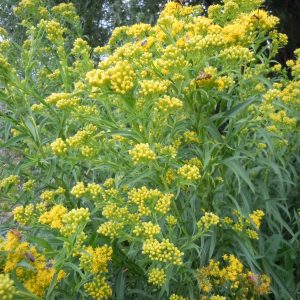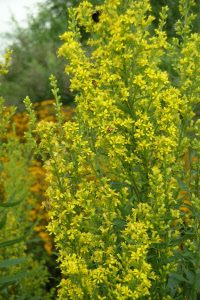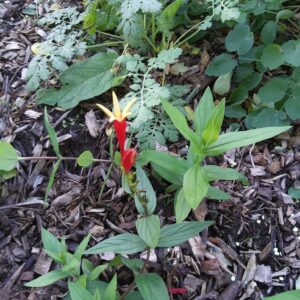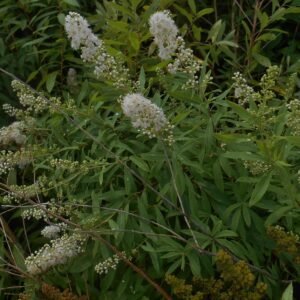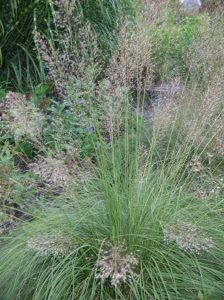Our Plants
Showing 521–528 of 587 results
-
Sisyrinchium angustifolium Blue eyed grass Z 3-9
Petite iris-like foliage sporting blue saucer-shaped flowers with bright yellow stamens in summer.
Petite iris-like foliage sporting blue saucer-shaped flowers with bright yellow stamens in summer.
Size: 12" x 6"
Care: Sun in well-drained soil
Native: North America, Wisconsin native.Mahuna Indians of So. California made a tea from the entire plant to expel stomach worms. In cultivation by 1732. Named by Philip Miller, gardener of the Chelsea Botanic Garden, in Gardeners’ Dictionary .
-
Solidago caesia syn. Solidago axillaris Blue-stemmed goldenrod, Wreath goldenrod Z 4-9
Graceful, arching wands of clustered gold, with contrasting blue-green stems in September-October. One of the last perennials to bloom. Clump forming, noninvasive perennial.
Graceful, arching wands of clustered gold, with contrasting blue-green stems, in September-October. Clump forming, noninvasive perennial.
Size: 18-24” x 16-20”
Care: part shade to shade in well-drained soil, drought tolerant
Native: Nova Scotia to WI, south to FL and west to TX, Wisconsin native
Wildlife Value: With both nectar and pollen this attracts, bees, wasps and flies. It is host to caterpillars of some moths.The Latin name is a combination of solidus and ago, meaning “I make whole”, referring to its historic medicinal uses. According to William Cullina it has antioxidant, diuretic, astringent and antifungal properties and was used to treat urinary tract and yeast infections, sore throats and diarrhea. (W. Cullina, NEWFS, p. 197) Named by Swedish botanist Linnaeus in 1753.
-
Solidago cutleri Cutler’s alpine goldenrod Z 3-9
Golden tufts of flowers on this mounding, compact, bone-hardy goldenrod July-September
Golden tufts of flowers on this mounding, compact, bone-hardy goldenrod July-September
Size: 6-10” x 12”
Care: sun in well-drained to moist well-drained soil
Native: Mountains of New England and NY, north through Nova Scotia
Wildlife Value: attracts butterfliesNamed for New England plant explorer Manasseh Cutler , Rhodora 10(113): 87. 1908 by M.L. Fernald
-
Solidago riddellii syn. Oligoneuron riddellii Riddell’s goldenrod, Stiff goldenrod Z 3-7
Sunshine yellow dome-topped flowers Sept.- Oct. Differs from S. gramnifolia by fewer leaves and its leaves fold toward the center vein.
Sunshine yellow dome-topped flowers Sept.- Oct. Differs from S. gramnifolia by fewer leaves and its leaves fold toward the center vein.
Size: 3’x2’
Care: sun in moist to moist well-drained soil.
Native: swath down middle of No. Am. From Hudson Bay to AK, incl. Wisconsin native
Wildlife Value: Loved by butterflies for its nectar – Small copper, Monarch, Giant swallowtail, Gray hairstreak, Clouded Sulphur, Fritillary, Pearl crescent, & Cloudless sulphur. Attracts praying mantises. Resists deer.The name Solidago from solidus and ago meaning to bring together. First published by German botanist Joseph Frank (1782-1835) who named it riddellii in honor of John Riddell who had collected it in Ohio before 1835.
-
Solidago speciosa Showy goldenrod Z 3-8
Broad spikes of erect panicles of mustard yellow welcome late summer into autumn
Broad spikes of erect panicles of mustard yellow welcome late summer into autumn
Size: 3-5’ x 12-18”
Care: Sun, any soil
Native: Central & eastern US, Wisconsin native
Wildlife Value: Loved by butterflies for its nectar – Small copper, Monarch, Giant swallowtail, Gray hairstreak, Clouded Sulfur, Fritillary, Pearl crescent & Cloudless sulfur. Attracts praying mantises.Meskwaki applied an infusion made of roots to burns. Chippewa used this plant for many things – to stop bleeding in the mouth and lungs, reduce pain from strains and sprains, as a stimulant and tonic and, mixed with bear grease, for a hair ointment. HoChunk and Winnebago made a blood purifier and remedied incontinence. Collected by Thomas Nuttall, English planthunter (1786-1859) who wandered over all of No. America searching for plants, animals, birds, and rocks from 1809 to 1842.
-
Spigelia marilandica Carolina pink, Woodland pinkroot Z 5-9
Stems topped with showy red tubes and fireworks-like yellow, five-pointed stars flare atop the tubes in late spring to early summer, later in the north. Deadhead for rebloom
Stems topped with showy red tubes and fireworks-like yellow, five-pointed stars flare atop the tubes in late spring to early summer, later in the north. Deadhead for rebloom
Size: 12-24” x 6-18”
Care: part to full shade in moist to moist well-drained soil
Native: NJ to Fl west to TX
Wildlife Value: nectar for hummingbirds; deer resistant
Awards: Pennsylvania Horticultural Society Gold Medal 2023Cherokee used this to purge parasites from intestines. In garden by 1753. Philip Miller’s Dictionary “the plant “is esteemed as the best medicine (in North America) yet known for the worms.” (1768) According to Jacob Bigelow in American Medical Botany, 1817 one doctor used it as a purgative and another as a narcotic.
-
Spiraea alba Meadowsweet, Du Roi Z 3-7
This short shrub sports white flower spikes 4” long blooming from June to August, deadhead for rebloom.
This short shrub sports white flower spikes 4” long, blooming from June to August, deadhead for rebloom.
Size: 3-4’ x 3-4’
Care: sun to part shade in moist to moist well-drained soil
Native: Northeastern 2/3 of North America, Wisconsin native
Wildlife Value: nectar attracts butterflies & hosts caterpillars of Spring azure butterfliesAlgonquin made a medicinal tea with Meadowsweet’s leaves and stems. Iroquois administered a decoction of mashed and powdered dry roots to remedy pain in the sides. 1st described in literature in 1772
**LISTED AS OUT OF STOCK BECAUSE WE DO NOT SHIP THIS ITEM. IT IS AVAILABLE FOR PURCHASE AT OUR RETAIL LOCATION.
-
Sporobolus heterolepsis Prairie dropseed Zone 3 – 9
Mound of graceful thinnest of grass blades
The description in the Chiltern Seeds catalog cannot be improved: “This is the most elegant and refined of the North American prairie grasses …the finest texture composed of the thinnest of thin, thread-like, glossy green blades,.. in autumn turning deep orange before fading to a light copper for the winter. In late summer the plants bear, on very slender stalks high above the foliage, unbelievably delicate, graceful flower panicles, excellent for cutting. ”One of internationally known garden designer Piet Oudolf’s 100 “MUST HAVE” plants, Gardens Illustrated 94 (2013)
Size: 2’ x 2’
Care: Full sun in well-drained soil
Native: from Canada in the north to Texas in the south, Wisconsin native
Wildlife Value: seeds are food for birds
Awards: Missouri Botanic Garden Plant of Merit & Great Plants for Great Plains Grass of the Year.Sporobolos is Greek from sporo meaning seed and ballein meaning to cast forth because the seed readily falls from the flower (or dropseed, the common name). Ojibwa “Medicine Society” used roots to cure sores & “remove bile.”

